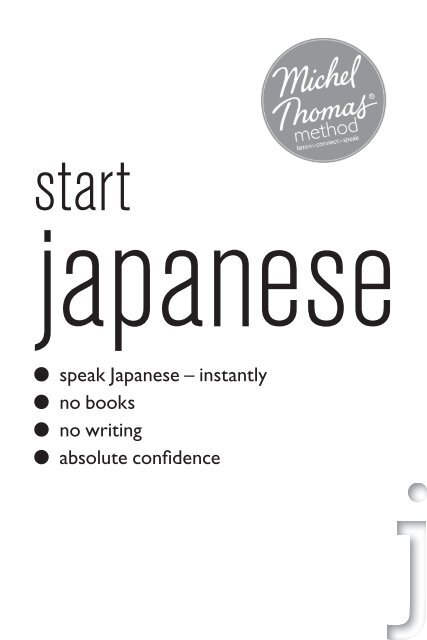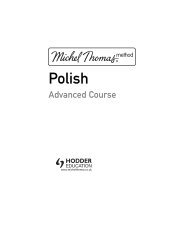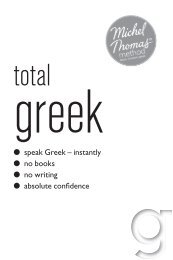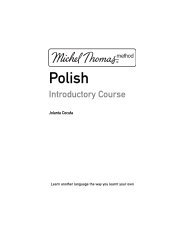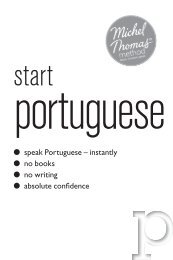Create successful ePaper yourself
Turn your PDF publications into a flip-book with our unique Google optimized e-Paper software.
start<br />
japanese<br />
● speak Japanese – instantly<br />
● no books<br />
● no writing<br />
● absolute confi dence<br />
j
To find out more, please get in touch with us.<br />
For general enquiries and for information on <strong>Michel</strong> <strong>Thomas</strong>:<br />
Call: 020 7873 6400 Fax: 020 7873 6325<br />
Email: mtenquiries@hodder.co.uk<br />
To place an order:<br />
Call: 01235 400414 Fax: 01235 400454 Email: uk.orders@bookpoint.co.uk<br />
www.michelthomas.co.uk<br />
You can write to us at:<br />
Hodder Education, 338 Euston Road, London NW1 3BH<br />
Unauthorized copying of this booklet or the accompanying audio material is<br />
prohibited, and may amount to a criminal offence punishable by a fine and/or<br />
imprisonment.<br />
First published in UK 2008 by Hodder Education, a division of Hachette Livre UK, 338 Euston Road,<br />
London NW1 3BH.<br />
Start Japanese Copyright © 2008, 2011, in the methodology, <strong>Thomas</strong> Keymaster Laguages LLC, all<br />
rights reserved; in the content, Helen Gilhooly and Niamh Kelly.<br />
All rights reserved. No part of this publication may be reproduced or transmitted in any form or by<br />
any means, electronic or mechanical, including photocopy, recording, or any information storage and<br />
retrieval system, without permission in writing from the publisher or under licence from the Copyright<br />
Licensing Agency Limited. Further details of such licences (for reprographic reproduction) may be<br />
obtained from the Copyright Licensing Agency Limited, Saffron House, 6–10 Kirby Street, London<br />
EC1N 8TS, UK.<br />
Typeset by Transet Limited, Coventry, England.<br />
Printed in Great Britain.<br />
Impression 10 9 8 7 6 5 4 3 2 1<br />
Year 2014 2013 2012 2011<br />
ISBN 978 1444 13918 1
Welcome to the <strong>Michel</strong><br />
<strong>Thomas</strong> Method<br />
Congratulations on purchasing the truly remarkable way to<br />
learn a language. With the <strong>Michel</strong> <strong>Thomas</strong> Method there’s no<br />
reading, no writing and no homework. Just sit back, absorb, and<br />
soon you’ll be speaking another language with confidence.<br />
The <strong>Michel</strong> <strong>Thomas</strong> Method works by breaking a language<br />
down into its component parts and enabling you to<br />
reconstruct the language yourself – to form your own<br />
sentences and to say what you want, when you want. By<br />
learning the language in small steps, you can build it up yourself<br />
to produce ever more complicated sentences.<br />
Perfected over 25 years, the all-audio <strong>Michel</strong> <strong>Thomas</strong> Method<br />
has been used by millions of people around the world.<br />
Now it’s your turn.<br />
To get started, simply insert the CD and press ‘play’!<br />
1
2 About<br />
<strong>Michel</strong> <strong>Thomas</strong><br />
<strong>Michel</strong> <strong>Thomas</strong> (1914–2005) was a gifted linguist who<br />
mastered more than ten languages in his lifetime and became<br />
famous for teaching much of Hollywood’s ‘A’ list how to speak<br />
a foreign language. Film stars such as Woody Allen, Emma<br />
Thompson and Barbra Streisand paid thousands of dollars each<br />
for face-to-face lessons.<br />
<strong>Michel</strong>, a Polish Jew, developed his method after discovering<br />
the untapped potential of the human mind during his traumatic<br />
wartime experiences. The only way he survived this period<br />
of his life, which included being captured by the Gestapo, was<br />
by concentrating and placing his mind beyond the physical.<br />
Fascinated by this experience, he was determined that<br />
after the war he would devote himself to exploring further<br />
the power of the human mind, and so dedicated his life to<br />
education.<br />
In 1947, he moved to Los Angeles and set up the <strong>Michel</strong><br />
<strong>Thomas</strong> Language Centers, from where he taught languages for<br />
over fifty years in New York, Beverly Hills and London.<br />
<strong>Michel</strong> <strong>Thomas</strong> died at his home in New York City on Saturday<br />
8th January 2005. He was 90 years old.
Start Japanese index<br />
Japanese is written in several scripts: Kanji (an ideographic system,<br />
using characters of Chinese origin), Hiragana and Katakana<br />
(syllabaries, in which a single character represents the sound of<br />
a syllable). Ro - maji (the Japanese language in the Romanised Latin<br />
alphabet) is used by foreign students of Japanese who have yet to<br />
master the Japanese scripts and by Japanese native speakers when<br />
using computer and other keyboards. In this track listing we use the<br />
Ro - maji script.<br />
CD1 Track 1<br />
Introduction<br />
Pronouncing Japanese. Japanese words in English: kimono; karate;<br />
karaoke. English words in Japanese are adjusted to Japanese speech<br />
patterns: kamera ‘camera’; dejikame ‘digital camera’; hoteru ‘hotel’; aisu<br />
kurı-mu ‘ice cream’; ko- hı- ‘coffee’; T. shatsu ‘T-shirt’.<br />
CD1 Track 2<br />
o kudasai ‘please may I have’; aisu kurı-mu o kudasai ‘Ice cream may<br />
I have’ = ‘May I have an ice cream, please?’ In Japanese, you don’t<br />
need words for ‘a’ or ‘the’. sumimasen ‘excuse me’; sumimasen aisu<br />
kurı-mu o kudasai ‘Excuse me, may I have an ice cream, please?’<br />
kore ‘this’; sore ‘that’; are ‘that over there’; sumimasen kore o kudasai<br />
‘Excuse me, please may I have this?’<br />
hai ‘yes’; do- zo ‘go ahead’<br />
CD1 Track 3<br />
tabemasu ‘to eat; I eat; she eats; he eats; you eat’: aisu kurı-mu o<br />
tabemasu ‘Ice cream [o] eat’ = ‘I eat ice cream’.<br />
sandoicchi ‘sandwich’<br />
3
4<br />
kore o tabemasu ‘This [o] eat’ = ‘I eat this’.<br />
This -masu form of Japanese verbs also covers the sense of ‘will’ (the<br />
future): kore o tabemasu ‘I will eat this’.<br />
nomimasu ‘to drink; ‘I/you/he etc. drink/will drink’: ko- hı- o nomimasu<br />
‘Coffee [o] drink’ = ‘I drink coffee’.<br />
ju- su ‘juice’; bı -ru ‘beer’<br />
CD1 Track 4<br />
ashita ‘tomorrow’: ashita ko- hı- o nomimasu ‘Tomorrow coffee<br />
[o] drink’ = ‘I will drink coffee tomorrow’ – the time expression<br />
generally comes first in a Japanese sentence. ashita ko- hı- o nomimasu<br />
could also mean ‘You will drink coffee tomorrow’, ‘He will drink<br />
coffee tomorrow’, ‘They will drink coffee tomorrow’ and so on, as<br />
the Japanese -masu verb form can refer to any person as the doer<br />
of the action of the verb, but in this track listing we will give the<br />
English translation with the person who was mentioned on the<br />
recording.<br />
sushi ‘rice with vinegar’: ashita sushi o tabemasu ‘I will eat sushi<br />
tomorrow’.<br />
CD1 Track 5<br />
ka = spoken question mark: sushi o tabemasu ka ‘Sushi [o] eat<br />
[question mark]’ = ‘Do you / Will you eat sushi?’ hai, tabemasu<br />
‘Yes, I eat’ = ‘Yes, I do / will eat it’ (no word for ‘it’ in this sort of<br />
expression).<br />
CD1 Track 6<br />
tokidoki ‘sometimes’: tokidoki sushi o tabemasu ‘Sometimes I eat sushi’.<br />
mainichi ‘every day’: mainichi ko- hı- o nomimasu ‘Every day I drink<br />
coffee’.
CD1 Track 7<br />
mimasu ‘to watch, look, see; I watch, look, see; I will watch, look, see’.<br />
terebi ‘television’: mainichi terebi o mimasu ‘Every day television [o]<br />
watch’ = ‘I watch television every day’: o is a marker to show which<br />
item in a sentence has the action done to it.<br />
ashita terebi o mimasu ‘I will watch television tomorrow’; mainichi<br />
terebi o mimasu ka ‘Do you watch television every day?’<br />
CD1 Track 8<br />
iie ‘no’: iie, sandoicchi o tabemasu ‘No, I will eat a sandwich /<br />
sandwiches’. In general there is no distinction in Japanese between<br />
singular and plural forms, so sandoicchi means both ‘sandwich’ and<br />
‘sandwiches’. In this track listing we will give the English translation<br />
with the singular or plural form according to what was said on the<br />
recording.<br />
konban ‘this evening, tonight’: konban sushi o tabemasu ka ‘Will you<br />
eat sushi tonight?’<br />
CD1 Track 9<br />
soshite ‘and’ (to link sentences): ashita terebi o mimasu. Soshite sushi o<br />
tabemasu ‘Tomorrow I will watch television. And I will eat sushi’.<br />
CD1 Track 10<br />
konban terebi o mimasu ka ‘Will you watch television tonight?’<br />
mainichi terebi o mimasu ka ‘Do you watch television every day?’<br />
hai, mimasu ‘Yes, I do (watch)’.<br />
5
6<br />
CD1 Track 11<br />
yomimasu ‘to read’<br />
manga ‘comic book’: manga o yomimasu ka ‘Do you read comic<br />
books?’<br />
nani ‘what’: nani o tabemasu ka ‘What [marker o] eat [question<br />
mark]’ = ‘What will you eat?’ konban nani o tabemasu ka ‘What will<br />
you eat tonight?’<br />
CD1 Track 12<br />
To form the negative, the ‘not’ or ‘don’t / doesn’t’ part of the verb,<br />
we remove the - masu ending and replace it by -masen: tabemasu ‘I<br />
eat’; tabemasen ‘I don’t eat’. This form also covers the future: konban<br />
terebi o mimasen ‘Tonight television [marker o] not watch’ = ‘I won’t<br />
watch television tonight’.<br />
manga o yomimasu ka ‘Do you read comic books?’ iie yomimasen<br />
‘No, I don’t read (them)’ = ‘No, I don’t’.<br />
CD1 Track 13<br />
kaimasu ‘to buy’: ashita kamera o kaimasu ‘Tomorrow I’ll buy / I’m<br />
going to buy a camera’.<br />
The way the Japanese language is used shows respect. The -masu<br />
verbs show politeness. If we use the negative (-masen) part of the<br />
verb with the question marker ka we are in fact making a polite<br />
suggestion: sushi o tabemasen ka ‘Sushi [marker o] not eat [question<br />
mark]’ = ‘Won’t you eat sushi?’ = ‘Would you like to eat (some)<br />
sushi?’
CD1 Track 14<br />
eiga ‘film, movie’: eiga o mimasen ka ‘Won’t you / Would you like to<br />
watch a film?’<br />
konsa- to ‘concert’: konban konsa- to o mimasen ka ‘Won’t you watch a<br />
concert tonight?’<br />
CD2 Track 1<br />
dore ‘which’: dore o kaimasu ka ‘Which [marker o] buy [question<br />
mark]’ = ‘Which will you buy?’<br />
CD2 Track 2<br />
desu ‘is; it is’: ko- hı- desu ‘It is coffee’ (we don’t use the marker o with<br />
desu because desu doesn’t indicate an action).<br />
ko- hı- desu ka ‘Is it coffee?’<br />
nan desu ka ‘What is (it) [question mark]’ = ‘What is it?’ (nani ‘what’<br />
is shortened to nan before desu ‘is’).<br />
desu also covers the plural verb form ‘are’: manga desu = ‘It is a<br />
comic book’ or ‘They are comic books’ (no word for ‘it’ or ‘they’ in<br />
this context).<br />
suki desu ‘I (etc.) like’, literally: suki ‘likeable’, desu ‘it is’: ‘likeable it is’ =<br />
‘I (etc.) like’.<br />
kara = indication of reason, so can be translated by ‘so, therefore’:<br />
suki desu kara kaimasu ‘Likeable (it) is therefore buy’ = ‘I like it<br />
therefore I’ll buy it’. In Japanese we give the reason first, then the<br />
result, so ‘I’ll buy it because I like it’ is also suki desu kara kaimasu.<br />
CD2 Track 3<br />
suki desu kara konban manga o yomimasu ‘I like it therefore I’ll<br />
read the comic book tonight’; suki desu kara ko - hı - o kudasai ‘I like it<br />
therefore may I have some coffee?’<br />
7
8<br />
CD2 Track 4<br />
omoshiroi ‘interesting’: omoshiroi desu ka ‘Is it interesting?’ omoshiroi<br />
desu kara terebi o mimasu ‘It is interesting so I’ll watch television’;<br />
omoshiroi desu kara ashita eiga o mimasu ‘It’s interesting therefore I’ll<br />
watch a / the film tomorrow’.<br />
CD2 Track 5<br />
oishii ‘delicious’: oishii desu ka ‘Is it delicious?’; oishii desu kara konban<br />
tabemasu ‘It’s delicious so I’ll eat it tonight’.<br />
CD2 Track 6<br />
do - shite ‘why’: do - shite manga o yomimasu ka ‘Why comic books<br />
[marker o] read [question mark]’ = ‘Why do you read comic books?’<br />
omoshiroi desu kara ‘They are interesting therefore’ = ‘Because they<br />
are interesting’: kara, the word which we use to give a reason, can<br />
also mean ‘because’. do - shite kaimasu ka ‘Why are you going to buy<br />
it?’ suki desu kara ‘Because I like it’.<br />
CD2 Track 7<br />
omoshiroi konsa - to ‘an interesting concert’; oishii ko - hı - desu ka ‘Is it (a)<br />
delicious coffee?’<br />
CD2 Track 8<br />
zehi ‘certainly’<br />
konban omoshiroi eiga o mimasen ka ‘Tonight interesting film [marker<br />
o] not watch [question mark]’ = ‘Won’t you watch an interesting<br />
film tonight?’ = ‘Would you like to watch an interesting film tonight?’<br />
hai, zehi ‘Yes, certainly’ = Yes, I would’.
CD2 Track 9<br />
kare ‘he’; kanojo ‘she’ – as ‘he’ and ‘she’ these are needed only for<br />
clarification or emphasis.<br />
to ‘with’. to is a marker which follows the word it belongs with:<br />
kare to ‘he with’ = ‘with him’; kare to eiga o mimasu ‘He with film<br />
[marker o] watch’ = ‘I will watch a film with him’; kanojo to konban eiga<br />
o mimasu / konban kanojo to eiga o mimasu ‘I will watch a film with her<br />
tonight’ (the order of kanojo to and konban can be interchanged).<br />
oishii covers sense of ‘nice’, i.e. when ‘nice’ means ‘delicious’.<br />
CD2 Track 10<br />
To make a suggestion in Japanese, in English ‘Let’s …’, take off the<br />
-masu ending from the verb and replace by -masho - : mimasho - ‘let’s<br />
watch’: eiga o mimasho - ‘Film [marker o] let’s watch’ = ‘Let’s watch<br />
a film’.<br />
CD2 Track 11<br />
shimasu ‘to do / to play’; gorufu ‘golf’; tokidoki gorufu o shimasu<br />
‘Sometimes golf [marker o] play’ = ‘I sometimes play golf’; konban<br />
gorufu o shimasho- ‘Let’s play golf tonight’.<br />
tenisu ‘tennis’; konban tenisu o shimasen ka ‘Tonight tennis [marker o]<br />
not play [question mark]’ ‘Won’t you play tennis tonight?’<br />
shigoto ‘work’: shigoto o shimasu ‘Work [marker o] do’ = ‘I work’;<br />
kanojo to shigoto o shimasu ‘I work with her’.<br />
CD2 Track 12<br />
To say ‘shall we’, we use the question mark word ka with the verb<br />
suggestion form -masho - : shigoto o shimasho - ka ‘Work [marker o]<br />
let’s do [question mark]’ = ‘Shall we work?’<br />
9
10<br />
CD2 Track 13<br />
ashita shigoto o shimasu kara konban gorufu o shimasho- ka<br />
‘Tomorrow we will work therefore shall we play golf tonight?’<br />
rirakkusu o shimasu ‘relax [marker o] do’ = ‘to relax’: rirakkusu o<br />
shimasho- ka ‘Shall we relax?’
Millions of people<br />
worldwide speak a<br />
new language thanks<br />
to the <strong>Michel</strong> <strong>Thomas</strong><br />
Method.<br />
Here’s what people say about <strong>Michel</strong> <strong>Thomas</strong>:<br />
“This guy is one of my heroes.”<br />
“What a legend. I love his method.”<br />
“Defi nitely the best way to learn.”<br />
“Just after a couple of days I’m confi dent that I will be able to<br />
speak directly.”<br />
“It’s the best way to learn a foreign language.”<br />
“Totally life changing.”<br />
“The <strong>Michel</strong> <strong>Thomas</strong> course is much the easiest to make progress with.”<br />
“He’s the best.”<br />
“A truly inspirational way to learn a language.”<br />
“With <strong>Michel</strong> you learn a language effortlessly.”<br />
j<br />
‘‘The nearest thing to<br />
painless learning.’’<br />
The Times


